AZ-305-KR 문제 1
https://docs.microsoft.com/en-us/azure/azure-sql/database/long-term-retention-overview In Azure SQL Database, you can configure a database with a long-term backup retention policy (LTR) to automatically retain the database backups in separate Azure Blob storage containers for up to 10 years
AZ-305-KR 문제 2
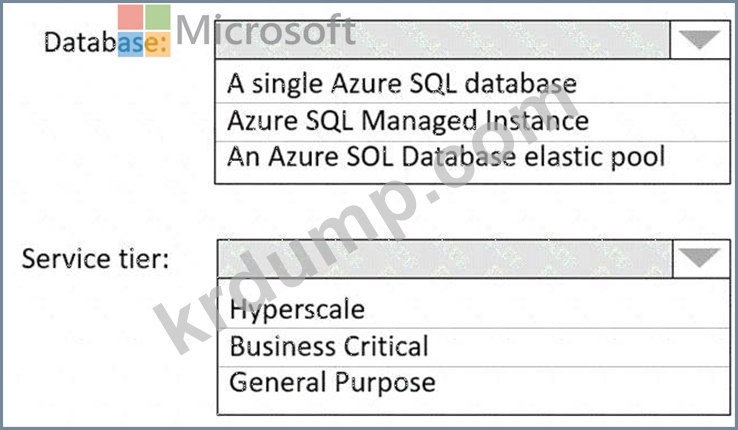
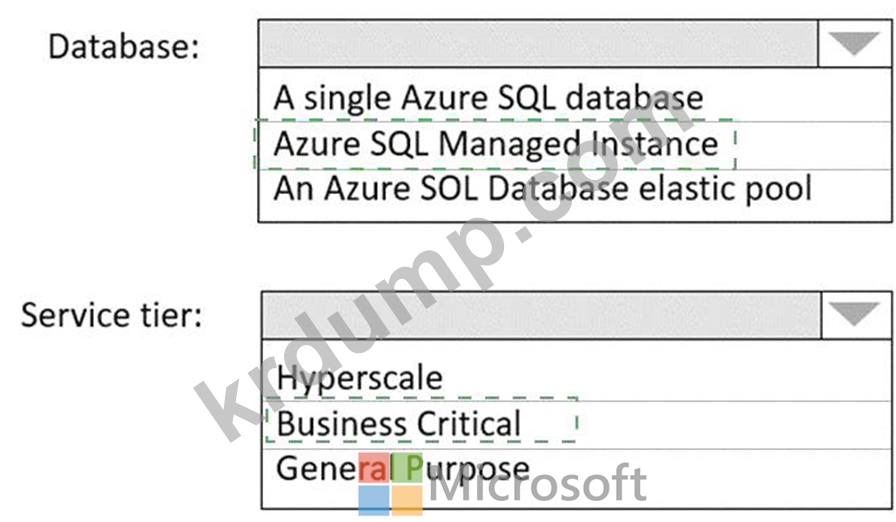
Explanation
Table Description automatically generated
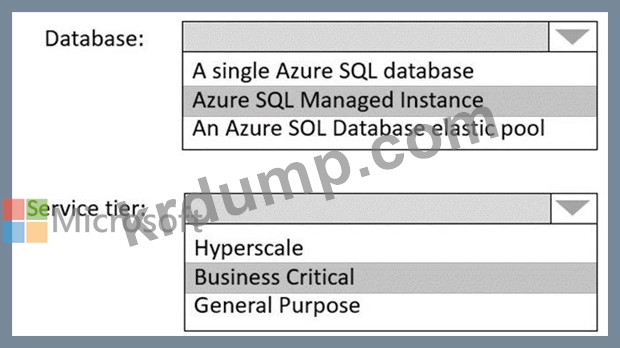
Box 1: SQL Managed Instance
Scenario: Once migrated to Azure, DB1 and DB2 must meet the following requirements:
* Maintain availability if two availability zones in the local Azure region fail.
* Fail over automatically.
* Minimize I/O latency.
The auto-failover groups feature allows you to manage the replication and failover of a group of databases on a server or all databases in a managed instance to another region. It is a declarative abstraction on top of the existing active geo-replication feature, designed to simplify deployment and management of geo-replicated databases at scale. You can initiate a geo-failover manually or you can delegate it to the Azure service based on a user-defined policy. The latter option allows you to automatically recover multiple related databases in a secondary region after a catastrophic failure or other unplanned event that results in full or partial loss of the SQL Database or SQL Managed Instance availability in the primary region.
Box 2: Business critical
SQL Managed Instance is available in two service tiers:
General purpose: Designed for applications with typical performance and I/O latency requirements.
Business critical: Designed for applications with low I/O latency requirements and minimal impact of underlying maintenance operations on the workload.
Reference:
https://docs.microsoft.com/en-us/azure/azure-sql/database/auto-failover-group-overview
https://docs.microsoft.com/en-us/azure/azure-sql/managed-instance/sql-managed-instance-paas-overview
Topic 1, Litware, Inc
Case Study
This is a case study. Case studies are not timed separately. You can use as much exam time as you would like to complete each case. However, there may be additional case studies and sections on this exam. You must manage your time to ensure that you are able to complete all questions included on this exam in the time provided.
To answer the questions included in a case study, you will need to reference information that is provided in the case study. Case studies might contain exhibits and other resources that provide more information about the scenario that is described in the case study. Each question is independent of the other questions in this case study.
At the end of this case study, a review screen will appear. This screen allows you to review your answers and to make changes before you move to the next section of the exam. After you begin a new section, you cannot return to this section.
To start the case study
To display the first question in this case study, click the button. Use the buttons in the left pane to explore the content of the case study before you answer the questions. Clicking these buttons displays information such as business requirements, existing environment, and problem statements. If the case study has an All Information tab, note that the information displayed is identical to the information displayed on the subsequent tabs. When you are ready to answer a question, click the button to return to the question.
Overview. General Overview
Litware, Inc. is a medium-sized finance company.
Overview. Physical Locations
Litware has a main office in Boston.
Existing Environment. Identity Environment
The network contains an Active Directory forest named Litware.com that is linked to an Azure Active Directory (Azure AD) tenant named Litware.com. All users have Azure Active Directory Premium P2 licenses.
Litware has a second Azure AD tenant named dev.Litware.com that is used as a development environment.
The Litware.com tenant has a conditional acess policy named capolicy1. Capolicy1 requires that when users manage the Azure subscription for a production environment by using the Azure portal, they must connect from a hybrid Azure AD-joined device.
Existing Environment. Azure Environment
Litware has 10 Azure subscriptions that are linked to the Litware.com tenant and five Azure subscriptions that are linked to the dev.Litware.com tenant. All the subscriptions are in an Enterprise Agreement (EA).
The Litware.com tenant contains a custom Azure role-based access control (Azure RBAC) role named Role1 that grants the DataActions read permission to the blobs and files in Azure Storage.
Existing Environment. On-premises Environment
The on-premises network of Litware contains the resources shown in the following table.

Existing Environment. Network Environment
Litware has ExpressRoute connectivity to Azure.
Planned Changes and Requirements. Planned Changes
Litware plans to implement the following changes:
* Migrate DB1 and DB2 to Azure.
* Migrate App1 to Azure virtual machines.
* Deploy the Azure virtual machines that will host App1 to Azure dedicated hosts.
Planned Changes and Requirements. Authentication and Authorization Requirements Litware identifies the following authentication and authorization requirements:
* Users that manage the production environment by using the Azure portal must connect from a hybrid Azure AD-joined device and authenticate by using Azure Multi-Factor Authentication (MFA).
* The Network Contributor built-in RBAC role must be used to grant permission to all the virtual networks in all the Azure subscriptions.
* To access the resources in Azure, App1 must use the managed identity of the virtual machines that will host the app.
* Role1 must be used to assign permissions to the storage accounts of all the Azure subscriptions.
* RBAC roles must be applied at the highest level possible.
Planned Changes and Requirements. Resiliency Requirements
Litware identifies the following resiliency requirements:
* Once migrated to Azure, DB1 and DB2 must meet the following requirements:
- Maintain availability if two availability zones in the local Azure region fail.
- Fail over automatically.
- Minimize I/O latency.
* App1 must meet the following requirements:
- Be hosted in an Azure region that supports availability zones.
- Be hosted on Azure virtual machines that support automatic scaling.
- Maintain availability if two availability zones in the local Azure region fail.
Planned Changes and Requirements. Security and Compliance Requirements
Litware identifies the following security and compliance requirements:
* Once App1 is migrated to Azure, you must ensure that new data can be written to the app, and the modification of new and existing data is prevented for a period of three years.
* On-premises users and services must be able to access the Azure Storage account that will host the data in App1.
* Access to the public endpoint of the Azure Storage account that will host the App1 data must be prevented.
* All Azure SQL databases in the production environment must have Transparent Data Encryption (TDE) enabled.
* App1 must not share physical hardware with other workloads.
Planned Changes and Requirements. Business Requirements
Litware identifies the following business requirements:
* Minimize administrative effort.
* Minimize costs.
AZ-305-KR 문제 3
당신은 무엇을해야합니까? 응답하려면 응답 영역에서 적절한 옵션을 선택하십시오.
참고: 각 올바른 선택은 1점의 가치가 있습니다.


Explanation
Graphical user interface, text, application Description automatically generated

Box 1: Azure AD Identity Protection
Azure AD Identity Protection helps you manage the roll-out of Azure AD Multi-Factor Authentication (MFA) registration by configuring a Conditional Access policy to require MFA registration no matter what modern authentication app you are signing in to.
Scenario: Users that manage the production environment by using the Azure portal must connect from a hybrid Azure AD-joined device and authenticate by using Azure Multi-Factor Authentication (MFA).
Box 2: Sign-in risk policy...
Scenario: The Litware.com tenant has a conditional access policy named capolicy1. Capolicy1 requires that when users manage the Azure subscription for a production environment by using the Azure portal, they must connect from a hybrid Azure AD-joined device.
Identity Protection policies we have two risk policies that we can enable in our directory.
* Sign-in risk policy
* User risk policy
Reference:
https://docs.microsoft.com/en-us/azure/active-directory/identity-protection/howto-identity-protection-configure-m
https://docs.microsoft.com/en-us/azure/active-directory/identity-protection/howto-identity-protection-configure-r
Topic 2, Fabrikam, inc Case Study A
Overview:
Existing Environment
Fabrikam, Inc. is an engineering company that has offices throughout Europe. The company has a main office in London and three branch offices in Amsterdam Berlin, and Rome.
Active Directory Environment:
The network contains two Active Directory forests named corp.fabnkam.com and rd.fabrikam.com. There are no trust relationships between the forests. Corp.fabrikam.com is a production forest that contains identities used for internal user and computer authentication. Rd.fabrikam.com is used by the research and development (R&D) department only. The R&D department is restricted to using on-premises resources only.
Network Infrastructure:
Each office contains at least one domain controller from the corp.fabrikam.com domain. The main office contains all the domain controllers for the rd.fabrikam.com forest.
All the offices have a high-speed connection to the Internet.
An existing application named WebApp1 is hosted in the data center of the London office. WebApp1 is used by customers to place and track orders. WebApp1 has a web tier that uses Microsoft Internet Information Services (IIS) and a database tier that runs Microsoft SQL Server 2016. The web tier and the database tier are deployed to virtual machines that run on Hyper-V.
The IT department currently uses a separate Hyper-V environment to test updates to WebApp1.
Fabrikam purchases all Microsoft licenses through a Microsoft Enterprise Agreement that includes Software Assurance.
Problem Statement:
The use of Web App1 is unpredictable. At peak times, users often report delays. At other times, many resources for WebApp1 are underutilized.
Requirements:
Planned Changes:
Fabrikam plans to move most of its production workloads to Azure during the next few years.
As one of its first projects, the company plans to establish a hybrid identity model, facilitating an upcoming Microsoft Office 365 deployment All R&D operations will remain on-premises.
Fabrikam plans to migrate the production and test instances of WebApp1 to Azure.
Technical Requirements:
Fabrikam identifies the following technical requirements:
* Web site content must be easily updated from a single point.
* User input must be minimized when provisioning new app instances.
* Whenever possible, existing on premises licenses must be used to reduce cost.
* Users must always authenticate by using their corp.fabrikam.com UPN identity.
* Any new deployments to Azure must be redundant in case an Azure region fails.
* Whenever possible, solutions must be deployed to Azure by using platform as a service (PaaS).
* An email distribution group named IT Support must be notified of any issues relating to the directory synchronization services.
* Directory synchronization between Azure Active Directory (Azure AD) and corp.fabhkam.com must not be affected by a link failure between Azure and the on premises network.
Database Requirements:
Fabrikam identifies the following database requirements:
* Database metrics for the production instance of WebApp1 must be available for analysis so that database administrators can optimize the performance settings.
* To avoid disrupting customer access, database downtime must be minimized when databases are migrated.
* Database backups must be retained for a minimum of seven years to meet compliance requirement Security Requirements:
Fabrikam identifies the following security requirements:
*Company information including policies, templates, and data must be inaccessible to anyone outside the company
*Users on the on-premises network must be able to authenticate to corp.fabrikam.com if an Internet link fails.
*Administrators must be able authenticate to the Azure portal by using their corp.fabrikam.com credentials.
*All administrative access to the Azure portal must be secured by using multi-factor authentication.
*The testing of WebApp1 updates must not be visible to anyone outside the company.
AZ-305-KR 문제 4
Azure 데이터베이스 및 서비스 계층이 복원력 및 비즈니스 요구 사항을 충족하는지 확인해야 합니다.
무엇을 구성해야 합니까? 응답하려면 응답 영역에서 적절한 옵션을 선택하십시오.
참고: 각 올바른 선택은 1점의 가치가 있습니다.
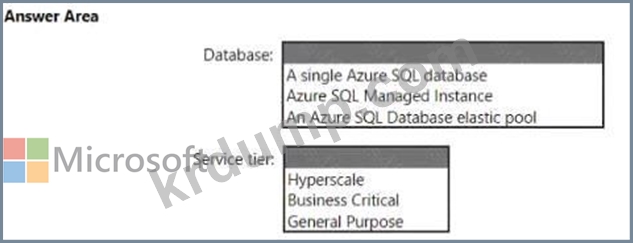
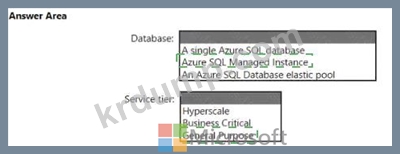
Explanation
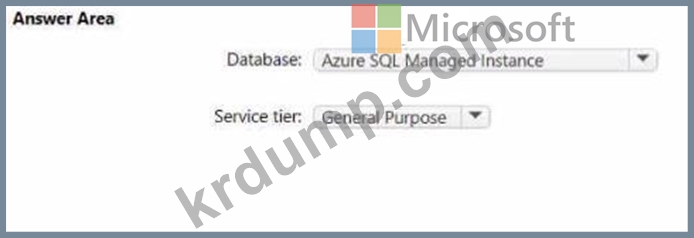
AZ-305-KR 문제 5
Directory synchronization between Azure Active Directory (Azure AD) and corp.fabrikam.com must not be affected by a link failure between Azure and the on-premises network. (This requires domain controllers in Azure) Users on the on-premises network must be able to authenticate to corp.fabrikam.com if an Internet link fails.
(This requires domain controllers on-premises)
프리미엄 번들
DumpTop 에서 공유하는 최신 AZ-305-KR 시험 덤프는 AZ-305-KR 시험패스를 도와드릴수 있습니다! DumpTop 은 최근 업데이트된 AZ-305-KR 시험자료를 제공해드립니다. DumpTop AZ-305-KR 덤프도 시험문제 변경에 따라 업데이트되었으며 오답도 수정되었습니다. DumpTop AZ-305-KR 덤프 최신버전을 공유받아보세요.
(430 Q&As 덤프, 30%OFF할인코드: KrDump)
- 다른 버전
- 1622Microsoft.AZ-305-KR.v2025-03-24.q127
- 1380Microsoft.AZ-305-KR.v2025-03-22.q143
- 889Microsoft.AZ-305-KR.v2025-02-15.q141
- 457Microsoft.AZ-305-KR.v2024-02-21.q140
- 596Microsoft.AZ-305-KR.v2024-02-08.q118
- 465Microsoft.AZ-305-KR.v2024-01-06.q115
- 1699Microsoft.AZ-305-KR.v2024-01-03.q141
- 453Microsoft.AZ-305-KR.v2023-12-26.q101
- 530Microsoft.AZ-305-KR.v2023-12-25.q120
- 746Microsoft.AZ-305-KR.v2023-12-08.q113
- 1530Microsoft.AZ-305-KR.v2023-12-06.q113
- 738Microsoft.AZ-305-KR.v2023-11-21.q117
- 571Microsoft.AZ-305-KR.v2023-11-08.q87
- 661Microsoft.AZ-305-KR.v2023-06-23.q94
- 871Microsoft.AZ-305-KR.v2023-06-05.q114
- 692Microsoft.AZ-305-KR.v2023-05-11.q94
- 최근 업로드
- 105Oracle.1Z0-908.v2025-09-06.q68
- 106Oracle.1Z0-1055-24.v2025-09-05.q29
- 167VMware.2V0-13.24.v2025-09-04.q75
- 113Qlik.QSBA2022.v2025-09-04.q17
- 115Oracle.1Z0-1073-23.v2025-09-03.q29
- 114Cisco.300-820.v2025-09-03.q187
- 113Oracle.1z0-1060-25.v2025-09-03.q26
- 123CIPS.L5M4.v2025-09-02.q13
- 136Fortinet.FCP_ZCS-AD-7.4.v2025-09-02.q12
- 113PECB.ISO-45001-Lead-Auditor.v2025-09-02.q14
PDF 파일 다운로드
메일 주소를 입력하시고 다운로드 하세요. Microsoft.AZ-305-KR.v2023-09-16.q8 모의시험 시험자료를 다운 받으세요.

